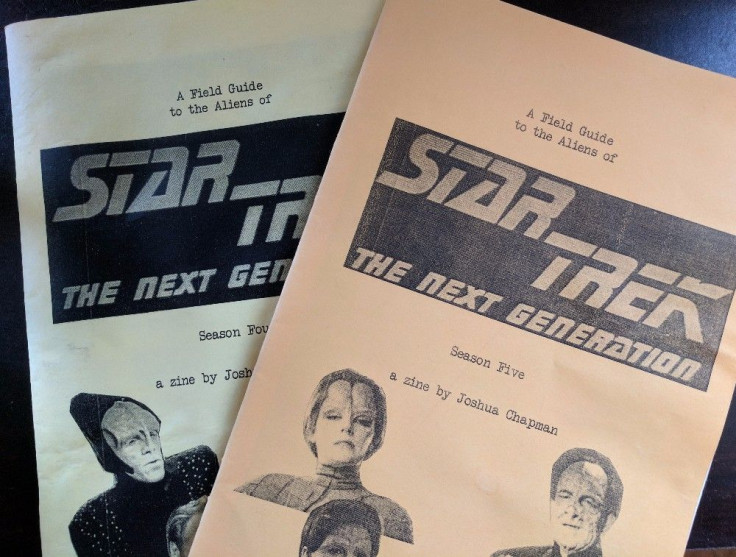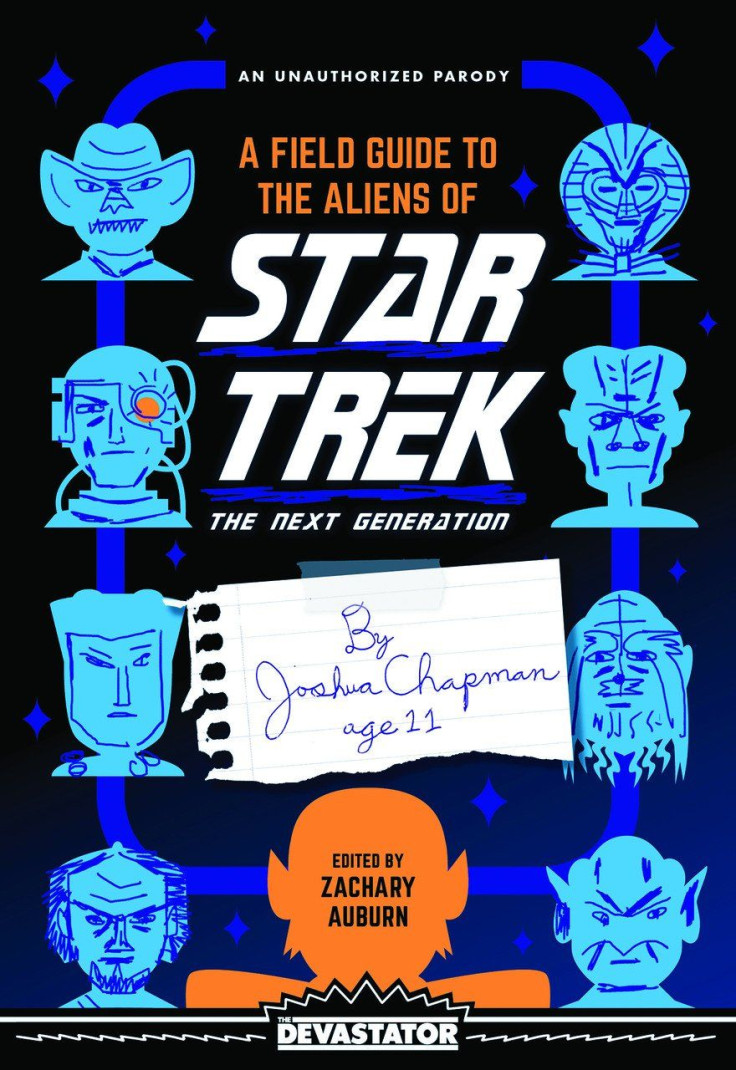Every Monday, Star Trek: The Next Generation aired on Pittsburgh affiliate WPTT-TV and Joshua Chapman recorded it onto VHS cassettes. It was 1990 when Chapman, an 11-year-old in the seventh grade, wrote his first zine (though he didn’t yet know what a zine was), A Field Guide to the Aliens of Star Trek: The Next Generation, for a creative writing assignment. “I think that this is the best show on TV, and I think people would benefit from knowing about the aliens that appeared on this show,” he wrote in cursive, across from his drawing of the Enterprise floating through Earth’s solar system.
By the end of high school, Chapman had cataloged the aliens appearing in all seven seasons of The Next Generation, dividing them over six pamphlet-like zines that he left at record store counters.
Twenty-seven years later Chapman’s zines have been collected in A Field Guide to the Aliens of Star Trek: The Next Generation, edited by Zachary Auburn, who discovered the Field Guides in 2010, “bound together by a decaying rubber band” at a garage sale.
At least, that’s the story. Actually, Auburn made Chapman up entirely, releasing the original zines in 2011 — fictional “artifacts” of an earlier era. “I’m still doing a pretty good job of confusing people as to what the actual nature of the authorship is, which I’m fine with,” Auburn told Player.One. “Part of the authenticity is not being entirely sure.”

Chapman’s authenticity doesn’t detract from the reality of his Field Guides, which are simultaneously a phenomenal resource for Star Trek fans, darkly funny and often tragic. Dodging the dry professionalism of a reference work and fandom pedantry, reading Chapman’s Field Guides feels like rediscovering the enthusiasm that brings people to sci-fi and Star Trek in the first place.
Chapman’s observations on The Next Generation are likely to remind readers of their own unsettling pubescence. “If I was getting married in a Betazoid wedding,” Chapman writes, describing the fully nude alien ceremony, “I would be really worried because everyone would be looking at me, but there would be lots of naked women there, and I might get an erection.”
Heartfelt moments are interwoven with deadpan Star Trek observations. Chapman devotes much of an entry on the Anticans, a predatory species from the Season 1 episode “Lonely Among Us,” to his cat:
“When I am feeling sad I will put her on my bed and lay down next to her and she will lick my hair for like half an hour. It makes me feel better when she does this because it is nice to get attention and it is like giving me attention is the most enjoyable feeling in the world for her and that is a really nice feeling to know she loves me that much. Anyways, these guys are the enemies of the Selay aliens.”
Throughout, Chapman’s problems at home bleed into his analysis of Star Trek and how he experiences its aliens. His Season 4 zine opens with the episode “Suddenly Human,” about a human boy raised by a warlike alien society, forced into adulthood too young. Chapman is jealous of the 14-year-old’s adult status and disillusioned by the adults in his own life, who berate Joshua for cutting himself, but fail to do anything to help him:
“Afterwards the counselor tried tell me that I shouldn’t cut myself but fuck him. If he had to live with my mom I bet he would cut himself too. These guys might be assholes but at least they don’t jerk their kids around.”
Chapman is a year older with each new issue. “So each one is him having another year of abuse from his mom and not getting any hope from the world and just getting cynical and angry and bitter over his rotten life,” Auburn said.
The dark adolescent moments peppered throughout A Field Guide to the Aliens of Star Trek: The Next Generation become ground for clear-eyed and sometimes cutting insights into TNG. Chapman loves going after lazily designed aliens like the Ja’Dar, with their turtle shell chins, or picking apart poorly socialized alien races like the “home schooled” Cytherians, stripping away science fiction metaphors to find the emotional core of alien beings in a way only a teenage asshole could. Chapman’s critiques come from his deep attachment to the show, making entries on great episodes, like “Darmok,” just as fun to read as his savage takes on terrible episodes, like “Sub Rosa.”
Chapman’s voice — cynical, savage, vulnerable — is so perfectly hormonal and teenage it’s easy to forget that he’s a fictional construct, just like a Star Trek alien (he would be furious to learn he’s more like his least favorite character, Deanna Troi, than Data, his most).
“I was thinking about a person telling a story without realizing they’re telling a story,” Auburn said. “And I was thinking about kids and how they can’t help but talk about the things they’re interested in. If you ask a kid about presidents and they’re interested in dinosaurs, they’ll find a way to talk about diplodocus.”
Coming off a book containing every outfit from the first season of The Golden Girls, Auburn wanted to do something with Star Trek next. “I realized the Star Trek thing and the kid idea were the same projects. I decided to have a kid talk about Star Trek in a way that details of his personal life were leaking through constantly.”
A huge part of the zine’s verisimilitude is conveyed in the medium. After the first issue, written in kid cursive, Auburn aged the presentation alongside his character. The second issue looks printed off a dot matrix printer. “For the third and fourth issues, I looked back at my report cards from those years and I saw what font my high school was using so I could match,” Auburn said.
“For me, a big part of having something be a book rather than a web page is that there should be value to the physical artifact,” Auburn said. “When people picked up the zines I wanted people to think ‘holy shit, a kid really made these in the 90s.’ There was no Wikipedia or whatever back then.” Even the pictures of each alien are snapshots taken off the TV screen.
This same presentation carries into the new paperback of the collected zines, which details Auburn’s search for the adult Chapman. The book ends with Auburn interviewing Chapman and getting his takes on the aliens from Star Trek: The Next Generation movies, bringing a surprisingly affecting close to a fandom zine doubling as a pitch-black, coming-of-age comedy.
It’s the invention of Joshua Chapman that makes A Field Guide to the Aliens of Star Trek: The Next Generation more than a catalog of characters. TNG becomes precious all over again through the eyes of Auburn’s troubled teen. Not everyone gets to live long and prosper, but at least we’ll always have Star Trek.
A Field Guide to the Aliens of Star Trek: The Next Generation by Joshua Chapman, edited by Zachary Auburn, is available now from Devastator Press. Auburn is also the author of How to Talk to Your Cat About Gun Safety.
















![[EG April 19] Best 'Stardew Valley' Mods That Will Change](https://d.player.one/en/full/226012/eg-april-19-best-stardew-valley-mods-that-will-change.png?w=380&h=275&f=955520b8313253ee3c39c791f6210f38)



